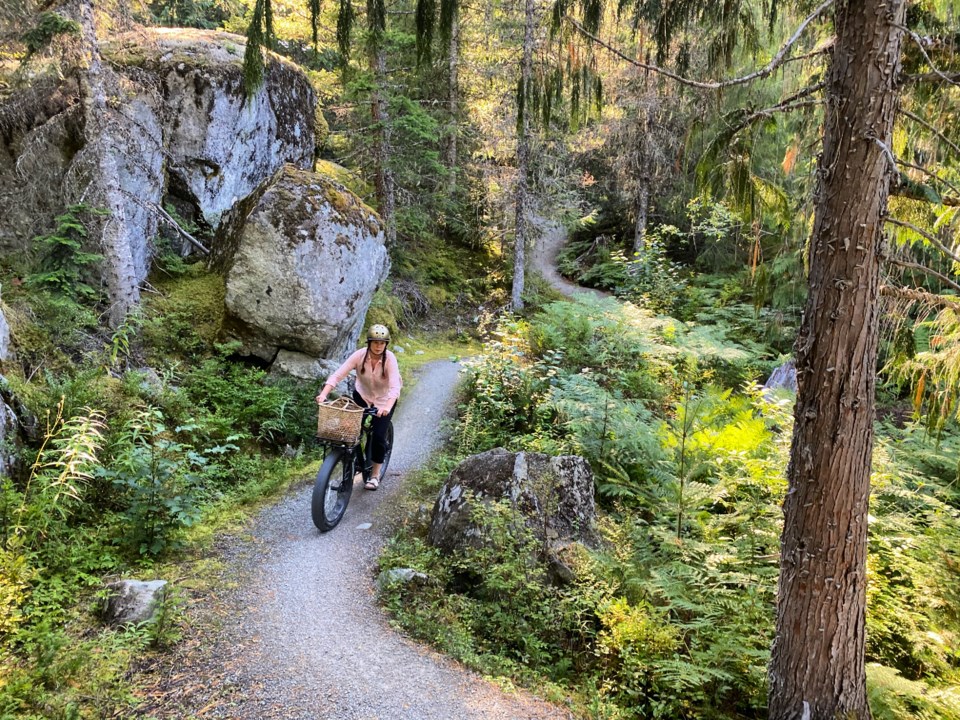Since mountain biking and hiking season is nigh, and many have already been out-and-about in Squamish or Pemberton when not enjoying the current primo mid-winter conditions on our mountains, it’s time to re-up some thoughts I’ve touched on before about trails—who uses them and why, and what we should keep in mind when building them.
Most outdoor adventures involve “trails” of some kind. Whether mountain biking, hiking, climbing, or even canoe-tripping, our endeavours usually follow previously tracked lines on the map. Humans have been creating trails forever, and in some places still employ them not for play, but the age-old search for water, food, and seasonal relocation. If this sounds much like what other animals do, you’re correct. In fact, animal (and, once upon a time, human) movement is the primary behavioural adaptation to the variability of critical resources in time and space.
For animals, biologists categorize movements into functional groupings such as foraging, dispersal, or migration, and study them with a range of modern technologies like radio telemetry, satellite tracking, remote-triggered cameras, and drones. The data accruing from these tell us one thing about animal movements: trails are superhighways for a range of terrestrial species from insects to megafauna.
As human societies evolved, trails connected us to other groups of humans. Pre-existing animal trails often comprised the most direct routes, but animals were also more than happy to use the passages we created to expand their own movements. This reciprocation continues.
In most cases, human use of longstanding forest trails doesn’t negatively affect the likelihood that other animals will use them (though some ungulates will associate certain trails with hunting danger), however, human activity can lead to changes in animal behaviour and distribution patterns if the level of activity is high enough to cause disturbance. Traditionally trained trail-builders keep this in mind, but it’s something many enthusiastic builders of today’s (mostly illegal) mountain bike trails don’t consider—or are even aware of. That needs to change given the ever-increasing impacts on ecosystems and wildlife everywhere, but particularly in the Sea to Sky.
To start, we’re most familiar with the trails of larger animals (ourselves included) yet pay little attention to their finer ecological points. For instance, well-used forest trails create space for flying insects, birds and bats to navigate the understory, supporting a food chain based on “edge” plants and the dung of the animals using those trails. Because trails allow light to penetrate where it often wouldn’t, they also become dispersal corridors for plants, which co-opt animal travellers as vectors to move their seeds—whether stuck to fur, or seeds consumed at one sunny spot and defecated out at another.
A concentration of plant food sources along trails can attract herbivores (e.g., deer), in turn providing reason for sit-and-wait predators (e.g., mountain lions) to hang around. We need to remember how much biological industry and behaviour our trails actually subsidize when we “suddenly” find it interfering with our own use—like startling a bear munching on berries that wouldn’t otherwise have grown there save for the trail’s interruption, or a snake using a nice warm mountain-bike trail to stretch out in the sun.
The problem compounds because human trailbuilders tend to enjoy the same types of places as sensitive ecosystems—south-facing slopes and meadows, open-canopy forest, and wetland, river and lake margins. Here, biologists can help meliorate environmental impact by showing where a trail might be routed so as not to come close to areas that might contain ground-nesting birds or reptile dens, or not to cut off such habitats from other areas utilized by these same creatures.
A good example in Pemberton is the highly endangered sharp-tailed snake, a burrowing, pencil-thin slug-eater that might be only a foot long in adulthood with a home-range radius of only 50 metres; where these animals occur, trails should be built so as not to cut between adjacent denning, reproductive, thermoregulatory and foraging habitat, all of which may be in a tiny area. Currently, Veronica Woodruff of Stewardship Pemberton is working with PORCA to reroute parts of some longstanding trails from the critical habitat they once cut through; the resulting detours are short, but effective for ecological restoration.
Trails also facilitate the movement of destructive invasive plants—both by wild animals and humans. We might not have fur, but easily carry plant seeds on our clothing, shoes and even tires (there’s even a name for this—anthropochory). Next time you start a hike or bike at a popular trailhead, take note of how far dandelions and other invasive plants follow the trail.
And it isn’t only riding that leads to this unholy seeding, but trailbuilding itself—particularly unsanctioned construction by non-professionals—given how easily noxious invasives like thistle, knapweed, burdock and orange hawkweed are spread by clothing, footwear, transported soil and uncleaned tools. Looked at this way, trailbuilding without undo concern for biological impacts can be like sending an IV drip of eco-destruction from über-disturbed frontcountry into pristine backcountry.
In the end, we tend to see trails we either modify or create as our own, but they never remain exclusive. Whether in use before we found them, or new routes now subsidizing the movement of other wildlife, it behooves us to treat trails as shared natural spaces with potential real impacts, and respect that while for us they may be a means to adventure, other organisms still count on them for their livelihood.
Leslie Anthony is a biologist, writer and author of several popular books on environmental science.




